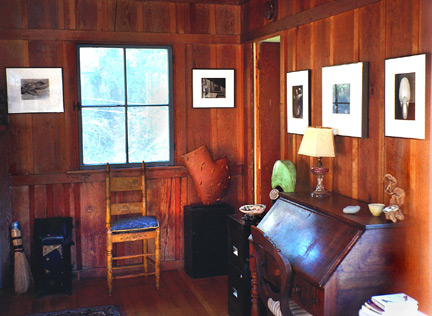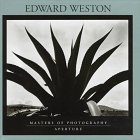Westons
By Katarzyna Majak
EDWARD WESTON dreamt of making a living out of his "personal work." Despite an ongoing enthusiasm of his friends and a few wealthy and faithful patrons, it was always a struggle. Thinking of his "personal work" he meant photographs taken in the proximity of Carmel -Point Lobos, which contributed his artistic asylum.
Entrance to Wildcat Hill
Today Edward's home on Wildcat Hill is home for his grandson, Kim and his wonderful wife, Gina. It was there that I searched for Edward’s spirit… A pilgrimage to Point Lobos allowed me to satisfy my longing to touch the roots and power of traditional photography. To confront the myth was to cure the jealousy of Edward’s courage to devote his life to photography.
A few words on the Master
A lot has been written on Edward. This truly American genius was, as Ben Maddow says, at the same time selfish and elevated. Cole, Edward’s son, remembered that, "Dad used to be modest and calm. This is how he influenced other people." Nancy Newhall working on an essay concerning controversies in photography in 1953 and described Weston as a "quiet man... with a big camera."
What was Edward like in reality? Looking for an answer I traveled to the other side of the world to be given a chance of spending magic hours in Edward’s home, with Cole and Kim, and to walk in Edward's footsteps at Point Lobos with my own camera.
Gina Weston
Reading a lot on a mysterious place, chosen by Edward as home, I could not resist visiting it. The moment Gina invited a homeless East-European to spend a night in Wildcat Hill, I felt honored, even chosen.
Gina promised to pick me up from the station. I expected a snobbish heiress of fame, so you might imagine how surprised I was to see a lovely, unpretentious woman smiling as she got out of her car. Me – first East European to visit them. Gina and Kim – third legendary generation . A happy family. No strangers to the struggle and passion of Edward.
Inside of Edward Weston's house
Wildcat Hill
We entered "Weston Driveway" and in moments we rounded a corner and I could see Wildcat Hill, a wooden cottage and studio, which Edward shared with Charis, his second wife. In this place he lived and tested his ideas about art.
Gina invites me in. On the walls - Edward’s original works...
When I see these magnificent photographs in that setting, I realize that my travel was not in vain. I am simply overpowered by the history of the place. Through the window I can see the Pacific. Point Lobos – where Edward took many of his best pictures, is so close…
Point Lobos
Edward, with Point Lobos in his mind, called himself "a prisoner of paradise." He started shooting at Point Lobos in 1929 and then, between 1938 and 1948, he worked on the last photographs of his life. These works show a rich psychological component compared to earlier, more formal works. This evolution was partly due to Weston’s maturation, development of Parkinson’s disease, deteriorating marriage and suffering caused by his sons’ separation in the military during WW II. The Weston during this period is not satisfied with technical virtuosity and compositional innovation. His sorrow mind searched for solace and meaning along the Pacific coast. His late works are rarely shown, probably due to their dissimilarity to earlier images, which were the source of his fame.
It was in Point Lobos where Edward shot a famous Cypress root...
Cypress Root - today
Cypress Root
Edward remembers shooting cypress root: "I did the cypress! Poor abused cypress,- photographed in all their picturesqueness by tourists, "pictorialists." […] But no one has done them-to my knowledge-as I have, and will. Details, fragments of the trunk, the roots. [...] Brett and Merle Armitage exclaimed over the negatives: one "like a flame," Merle said.*
During the first walk through Point Lobos, we see the northern coast. Gina and Kim show places where Edward took some of his famous photographs. Most of them are out of reach today, as Point Lobos has become a reserve. Tourists (and photographers) are obliged to stay on the designated paths. Fortunately the cypress root is located near one of them. It has lost a bit of former splendor , but it is unmistakable.
The evening – return to Wildcat Hill to see Edward’s darkroom. It has not changed since Edward’s death. It is as if no time has passed, and he has just walked out of that small room to get a cup of coffee.
Edward Weston's darkroom
Darkroom
In both his private life and photography Weston limited his needs. The darkroom was used only to make contact prints. A simple bulb served a light source (a ritual still preserved by the Westons). Edward used to regulate the power of the light by covering the bulb with paper. The bulb, hanging on a long chord, swings slightly...
Darkroom procedures were simplified. Edward told his sons to obtain detail in lights. He burned keeping the light source above the lights of the print. Sometimes he cut paper to make shadows and decrease exposure of some parts of the negative. In his leaflet written in 1934 for Los Angeles Museum, he opted for direct contact printing, absolute absence of any kind of manipulation while printing. If a larger print was desired, he would rephotograph finished prints with his 8x10 camera. The resulting negative could then once again be contact printed.
Negative by Edward Weston, print by Cole Weston...
Negatives
Would anyone be comfortable being entrusted with Edward's negatives? Probably Brett’s negatives might make one feel a bit safer as he did not allow anybody to print from them. Prior to his death Brett cut holes in negatives that he did not destroy. Initially Brett was not interested in preserving his negatives. The Center for Creative Photography in Tucson, Arizona convinced him otherwise. A small collection of Brett's negatives are now house in the Center's vault right next to Edward's. The Weston legacy preserved for all time.
During my time at Wildcat Hill, Kim and Cole developed a negative just shot by Kim at Point Lobos.. Everything was done in accordance with Edward’s procedure in pyro developer. One can get an impression that time has not influenced Edward’s simplicity.
Kim then made a contact print from one of Edward’s negatives, under a bulb, and with Amidol developer, using his hands in the developer. "‘I like to feel the paper," he explains...
Cole talks about his father
Kids
Edward’s relations with his sons were warm and close. He once said to Nancy Newhall that his priorities in life were: his sons, his work, love... At the end of his life Parkinson’s disease made picture taking impossible. His sons assisted. Most often Cole.
Cole Weston
As Cole got older, talking about his dad became more difficult – hence an idea to record Cole’s memories – a short video on Edward’s life is entitled ‘A Man not the Myth’. Cole remembers a surprising amount of detail.
Weston Beach Cole on His Father
Edward used to say that despite the same camera, film and developer they were using, their works came from two separate artists on various level of development.
Cole remembers the day when he assisted Edward (not well at the time) in Point Lobos. Edward was busy looking for an photograph while Cole took care of the equipment and made the photograph possible. He used to carry Edward to inaccessible places when Edward became too disabled to walk on his own...
Last decade
The last 10 years of Edward’s life were not spent on active photography. Rather than that he remained the Master and Point Lobos Host. Students as well as admirers were all invited. He did not complain about the disease which gradually disabled him from simple movement.
One morning in 1958 he sat in his chair looking through the window. It was the last morning of his life…
His sons cremated the body; his ashes were scattered on Pebble Beach – one of the places he made his own. Since 1979 the place has been called ‘Weston’s Beach’.
Text and photo by
Katarzyna Majak
* Edward Weston Daybooks New York 1966 vol. 2 s. 114
See also:
Selected books:
Edward Weston (Aperture Masters of Photography)
R.H. Cravens
Hardcover - 96 pages (December 1997)
Aperture; ISBN: 0893817473
Gathers landscapes, portraits, nudes, and still lifes by Weston and discusses his approach to photography.Edward Weston: Portraits
Cole Weston (Foreword), Edward Weston
Hardcover - 96 pages (1 October, 1995)
Aperture; ISBN: 0893816051Edward Weston
Manfred Heiting (Editor)
Paperback - 192 pages (27 April, 2001)
Benedikt Taschen Verlag; ISBN: 3822855480
From still lifes of vegetables to shells to the human nude, Weston's photographs demonstrate exacting precision and tonal depth. A compact overview of his starkly original work, this book is an introduction to the photographer.Edward Weston: Nudes
Edward Weston (Photographer)
Paperback - 116 pages (1993)
Aperture; ISBN: 0893815322Edward Weston: the Last Years in Carmel
Edward Weston, David Travis
Hardcover - 144 pages (1 June, 2001)
Art Institute of Chicago; ISBN: 086559192XEdward Weston: a Legacy
Jennifer A. Watts, Edward Weston
Hardcover - 288 pages (1 April, 2003)
Merrell Publishers; ISBN: 1858942063
Not yet published: you may still order this title. We will dispatch it to you when we receive it from the publisher.
back to FOTOTAPETA's front page
Copyright © 1997-2025 Marek Grygiel / Copyright for www edition © 1997-2025 Zeta-Media Inc.
10 - 12 - 2003













